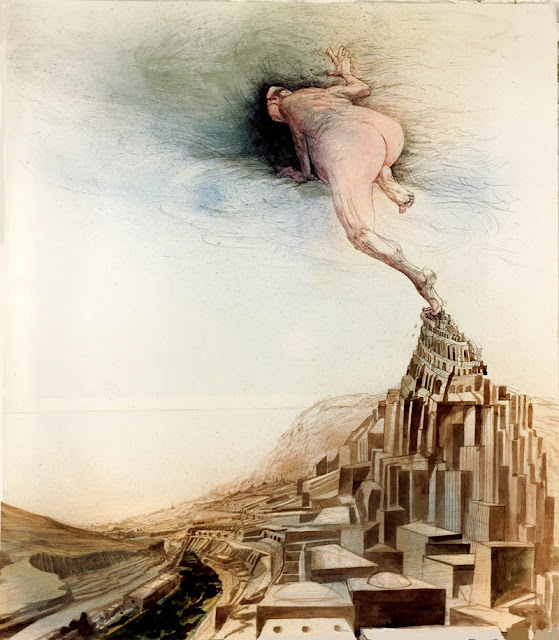This morning I had an illuminating chat with the legendary illustrator / cartoonist Ralph Steadman.
Fifty years ago Steadman became famous for his scandalous political drawings and his illustrations for Hunter Thompson's books, such as Fear and Loathing In Las Vegas.
 |
| Henry Kissinger (detail) |
 |
| Ronald Reagan (detail) |
Steadman's drawings from decades ago remain as relevant as today's headlines:
 |
| Viral Menace |
 |
| GOD Gets the Hell Out |
Steadman's fiery indignation has not softened a bit over the intervening years. ("Trump is the worst creature who lives on this earth," he tells me.)
I spoke with Steadman about his distinctive combination of looseness and control. His drawings often incorporate accidents of nature-- splatters of ink delivered Jackson Pollock-style-- along with the technical drawing skills of a former draftsman for an engineering factory of the De Havilland Aircraft Company.
 |
| A wall decoration at Steadman's recent retrospective exhibition |
He described his receptiveness to the accidental:
In a way it starts out like an abstract work of art.... Sometimes I put a piece of paper down... and I'll drop the water [that I use to clean my brushes] on in it from about 3 foot up. The smellier the water, the more interesting the patterns you get when it dries. You get textures and things that are marvelous. Decay is an interesting part of the process.Steadman also flings ink and sprays color which he blows through a tube. He says he enjoys the surprises that result from such abstract beginnings:
It surprises me as much as anybody else. That's what makes drawing interesting. I look at the accidents from the splatters and ask myself, "How did that happen?"That's what he dislikes about using computers for art:
The only thing I like about using a computer is that it can fill in a color. Otherwise computers are too beholden to rules and regulations. There aren't so many surprises. With a drawing [by hand] you can still say, "oh my god, that's interesting."After those spatters "express a creature or a person or a group.... " he develops the drawing with "the straight lines and circles" that he learned at the De Havilland Aircraft Company.
Given his receptiveness to chance and experimentation, it shouldn't be surprising that Steadman's all time favorite artist is Marcel Duchamp because of Duchamp's discovery process. He says, "Duchamp's work is so unexpected.... Everything's an experiment, and that's how it should be."
After a conversation that spanned fine art, illustration and cartooning I asked Steadman what he considered himself. "A Welshman" he replied.




5 comments:
Today newspapers are afraid to print editorial cartoons because they don't dare offend readers. Steadman's cartoons were great because they were so offensive. They scared me.
JSL
I agree. They are so effective because they are ugly but perfectly rendered ugly -- and scary. The big butt God crawling back into his hole with a fearful glance back is reminscent of something shocking that E.M. Cioran heard his father (who was a Priest) say late one night: "God is an Old Hog."
And Kissinger and Reagan get the reveal they deserve.
Such wonderful blasphemy from the culture of late 1960's seems like lost innocence now, like adults who grew up on the mockery and scorn of Mad magazine and continued it with a seriousness that delivered powerful blows to those who deserved it. We have seem to have no one like Steadman now, especially now that we really need them. How is not possible to effectively scorn and mock the idiots now in charge of the planet? Who do we blame for the lameness of artistic critics now? I'd like to blame someone.
A phobia that prevents so many business owners from being successful, even though they have top quality products and services, is fear and loathing of selling.
Snappa's drag-and-drop editor, it’s quick and easy to create your own graphics for blog posts, social media profiles and ads. The tool provides access to more than half a million free stock photos, 70,000+ vectors and shapes, and 200+ fonts. It's free to download up to 5 files per month, or $10 a month for unlimited downloads.
I have to assume you held a four hour conversation with Ralph Steadman to do more with it than provide these few quotes above. Will there be a full transcript of the conversation published in some appropriate time or place, (a book, a magazine article, or...)?
Post a Comment